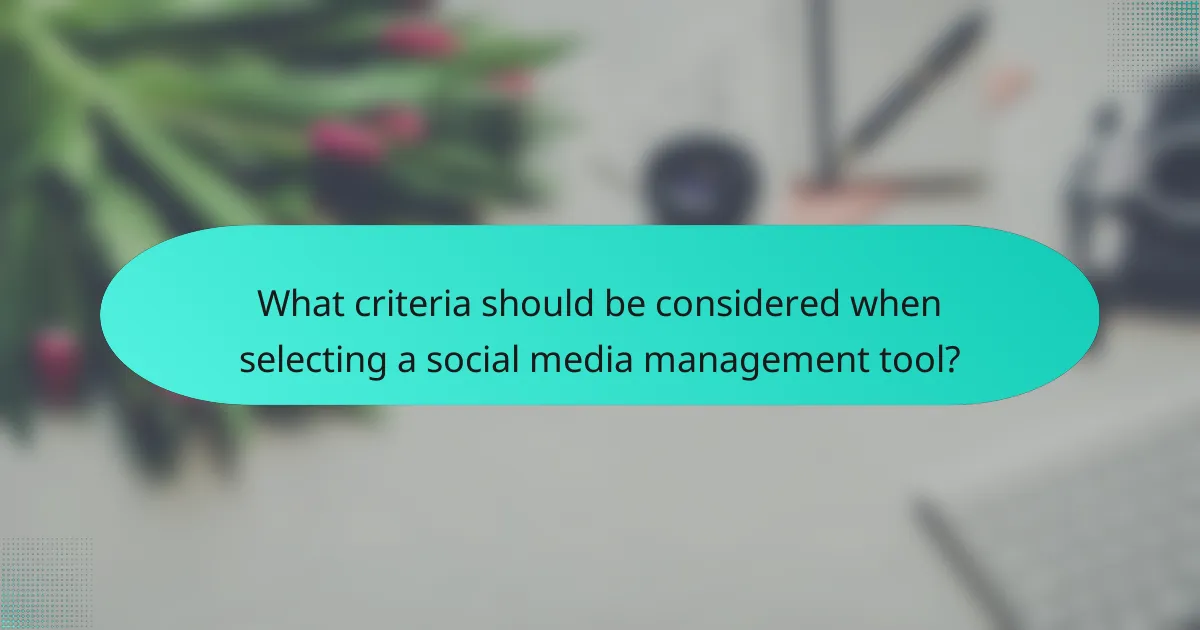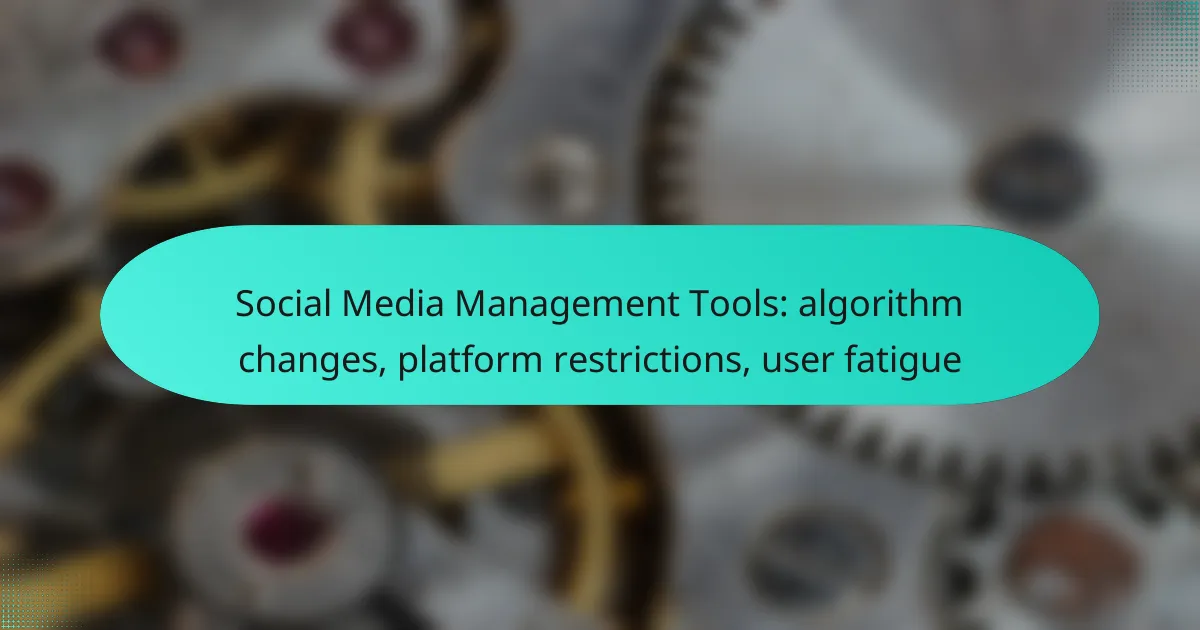In the rapidly evolving landscape of social media, effective management tools are essential for businesses to maintain their online presence and engage with audiences. With constant algorithm changes and platform restrictions, companies must adapt their strategies to ensure visibility and interaction. User fatigue also poses a challenge, making it crucial to create compelling content that resonates with audiences while utilizing the right tools to streamline efforts.

What are the best social media management tools in Canada?
The best social media management tools in Canada help businesses streamline their online presence, manage posts, and analyze performance across various platforms. Popular options include Hootsuite, Buffer, Sprout Social, Later, and SocialBee, each offering unique features tailored to different needs.
Hootsuite
Hootsuite is one of the most widely used social media management tools in Canada, known for its comprehensive dashboard that allows users to manage multiple accounts from one place. It supports scheduling posts, monitoring social media activity, and analyzing performance metrics.
Consider Hootsuite if you require robust analytics and team collaboration features. It offers various pricing tiers, making it accessible for both small businesses and larger enterprises.
Buffer
Buffer is a user-friendly tool that focuses on scheduling and publishing content across various social media platforms. It allows users to create a posting schedule and provides insights into post performance.
This tool is ideal for businesses looking for simplicity and efficiency. Buffer’s pricing is competitive, with options for individuals and teams, making it suitable for a range of users.
Sprout Social
Sprout Social offers a powerful suite of tools for social media management, including scheduling, monitoring, and reporting features. It is particularly known for its customer relationship management capabilities, allowing businesses to engage effectively with their audience.
Choose Sprout Social if your focus is on customer engagement and detailed analytics. Its pricing reflects its advanced features, which may be more suitable for medium to large businesses.
Later
Later specializes in visual content scheduling, making it a great choice for businesses that rely heavily on image and video posts, such as those in fashion or food industries. Its drag-and-drop calendar simplifies the planning process.
This tool is particularly beneficial for Instagram users, as it allows for easy visual planning. Later offers a free plan with limited features, which can be a good starting point for small businesses.
SocialBee
SocialBee focuses on content categorization, allowing users to organize their posts into different categories for more effective scheduling. This feature helps maintain a balanced content mix across platforms.
SocialBee is ideal for businesses that want to ensure a diverse content strategy. Its pricing is flexible, catering to various business sizes, and it includes a 14-day free trial to test its features.

How to adapt to algorithm changes on social media platforms?
To adapt to algorithm changes on social media platforms, regularly reassess your content strategy and engagement tactics. Staying informed about updates and adjusting your approach will help maintain visibility and audience interaction.
Regularly update content strategies
Regularly updating your content strategies is crucial for staying relevant in the face of algorithm changes. Focus on creating high-quality, engaging content that resonates with your target audience. Experiment with different formats, such as videos, stories, or polls, to see what garners the most interaction.
Consider scheduling content to align with peak engagement times, which may vary across platforms. For example, posting during weekday afternoons often yields better results than weekends. Monitor trends and adapt your themes to reflect current events or popular topics.
Utilize analytics tools
Utilizing analytics tools is essential for understanding how algorithm changes affect your content’s performance. Platforms like Facebook Insights or Instagram Analytics provide valuable data on engagement rates, reach, and audience demographics. Regularly review these metrics to identify patterns and adjust your strategies accordingly.
Set specific goals for your social media presence, such as increasing engagement by a certain percentage or growing your follower base. Use analytics to track progress toward these goals and refine your approach based on what the data reveals. Avoid relying solely on vanity metrics like likes; focus instead on meaningful interactions and conversions.

What are the impacts of platform restrictions on social media management?
Platform restrictions significantly affect social media management by limiting the reach and engagement of posts, which can hinder brand visibility and audience interaction. These limitations often force businesses to adapt their strategies to maintain effectiveness in a changing landscape.
Limited reach and engagement
Platform restrictions can drastically reduce the organic reach of posts, meaning fewer users see content without paid promotion. For instance, algorithms may prioritize certain types of content or user interactions, making it essential for brands to create highly engaging and relevant posts to capture attention.
As a result, businesses may find that their posts receive lower engagement rates, which can affect overall brand awareness. To counteract this, brands should focus on producing high-quality content that resonates with their target audience and encourages shares and comments.
Increased reliance on paid advertising
With organic reach declining due to platform restrictions, many businesses are increasingly turning to paid advertising to ensure their content is seen. This shift can lead to higher marketing costs, as brands must allocate budgets for ads to maintain visibility on platforms like Facebook and Instagram.
To optimize advertising spend, businesses should consider targeting specific demographics and interests, using A/B testing to refine their ad strategies. Additionally, monitoring ad performance regularly can help identify which campaigns yield the best return on investment, allowing for more efficient budget allocation.

How to combat user fatigue in social media?
To combat user fatigue in social media, focus on refreshing your content strategy and enhancing user engagement. By diversifying content formats and incorporating interactive elements, you can keep your audience interested and active.
Diversify content formats
Diversifying content formats is essential to maintain user interest and combat fatigue. Consider mixing videos, infographics, podcasts, and live streams with traditional posts to cater to different preferences. For instance, a single topic can be presented as a video tutorial, an infographic summary, and a blog post.
When planning your content, aim for a balance. A good rule of thumb is to use a mix of formats, such as 40% videos, 30% images, and 30% text-based posts. This variety can help reach a broader audience and keep existing followers engaged.
Engage with interactive content
Interactive content, such as polls, quizzes, and contests, can significantly enhance user engagement. These elements invite users to participate actively rather than passively consuming content. For example, a simple poll about user preferences can generate valuable feedback and foster a sense of community.
To effectively implement interactive content, consider setting aside a portion of your weekly posts for these activities. Aim for at least one interactive post per week to maintain momentum and encourage ongoing participation from your audience.

What criteria should be considered when selecting a social media management tool?
When selecting a social media management tool, consider factors such as integration capabilities, user interface, pricing, and scalability. These criteria will help ensure that the tool meets your specific needs and enhances your social media strategy.
Integration capabilities
Integration capabilities refer to how well the social media management tool connects with other platforms and applications. A tool that seamlessly integrates with your existing systems, such as CRM software or email marketing platforms, can streamline workflows and improve efficiency.
Look for tools that offer API access or pre-built integrations with popular services like Google Analytics, Shopify, or Mailchimp. This can save time and reduce the need for manual data entry, allowing for a more cohesive marketing strategy.
User interface and experience
The user interface and experience are crucial for ensuring that your team can effectively use the social media management tool. A clean, intuitive design can enhance productivity and reduce the learning curve for new users.
Evaluate the layout, navigation, and overall usability of the tool. Consider conducting trials or demos to assess how easily your team can schedule posts, analyze performance, and engage with followers. A user-friendly interface can significantly impact your team’s ability to manage social media efficiently.

What are the emerging trends in social media management tools?
Emerging trends in social media management tools focus on leveraging advanced technologies and addressing user concerns. Key developments include AI-driven analytics for better insights and an increased emphasis on privacy features to comply with regulations and enhance user trust.
AI-driven analytics
AI-driven analytics are transforming how businesses interpret social media data. These tools utilize machine learning algorithms to analyze user engagement, content performance, and audience behavior, providing actionable insights that can inform marketing strategies.
For instance, platforms may offer predictive analytics that forecast trends based on historical data, helping brands to tailor their content more effectively. Businesses should consider tools that integrate seamlessly with existing systems and provide real-time data to stay ahead of the curve.
Increased focus on privacy features
With growing concerns over data privacy, social media management tools are prioritizing features that protect user information. Compliance with regulations such as GDPR in Europe and CCPA in California is becoming essential for platforms to maintain user trust and avoid penalties.
Tools now often include options for data encryption, user consent management, and transparent data usage policies. Companies should evaluate these privacy features when selecting tools to ensure they align with legal requirements and enhance their reputation among users.

How to measure the effectiveness of social media management strategies?
Measuring the effectiveness of social media management strategies involves tracking key performance indicators (KPIs) that reflect engagement, reach, and conversion. These metrics help assess how well your strategies resonate with your audience and contribute to your overall business goals.
Key Performance Indicators (KPIs) to Track
Common KPIs for social media effectiveness include engagement rates, follower growth, and conversion rates. Engagement rates can be calculated by dividing the total interactions (likes, shares, comments) by the total followers or impressions. Follower growth indicates the increase in audience size over time, while conversion rates measure how many social media interactions lead to desired actions, such as website visits or purchases.
Consider using a combination of quantitative and qualitative metrics to get a comprehensive view. For instance, while numbers provide hard data, sentiment analysis can offer insights into how your audience feels about your brand.
Tools for Measurement
Utilize social media analytics tools like Hootsuite, Sprout Social, or Google Analytics to streamline your measurement process. These platforms provide in-depth reports on your KPIs, allowing for easy tracking and comparison over time.
For example, Google Analytics can show how much traffic is coming from social media channels, while Hootsuite can provide detailed engagement statistics. Choose tools that align with your specific goals and budget, as some may offer free versions while others require subscriptions.
Analyzing Results and Adjusting Strategies
Regularly analyze your results to identify trends and areas for improvement. Look for patterns in high-performing posts or campaigns to understand what resonates with your audience. If certain types of content lead to higher engagement, consider focusing more on those formats.
Be prepared to adjust your strategies based on your findings. If you notice a decline in engagement, it may be time to refresh your content or explore new platforms that align with your target audience’s preferences.
